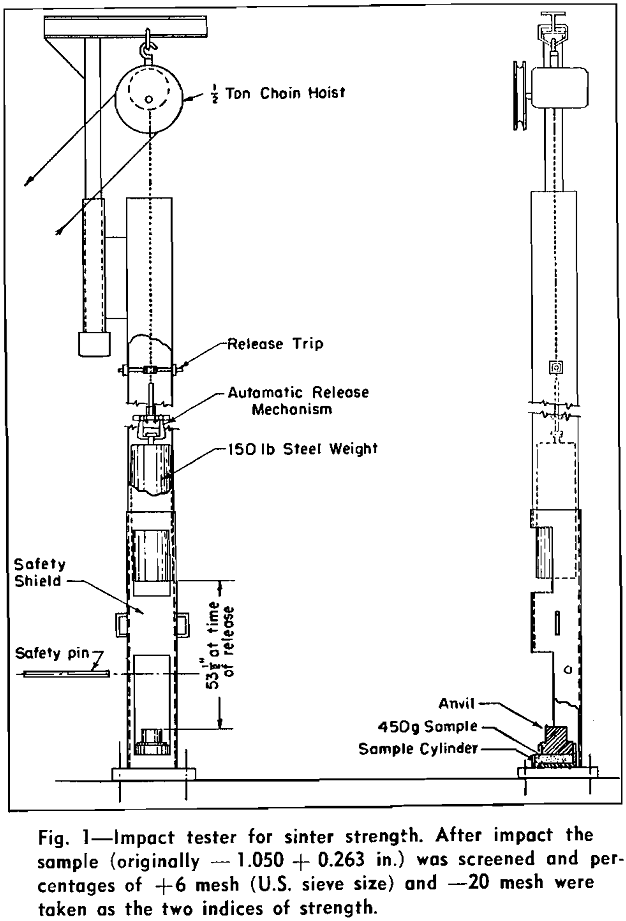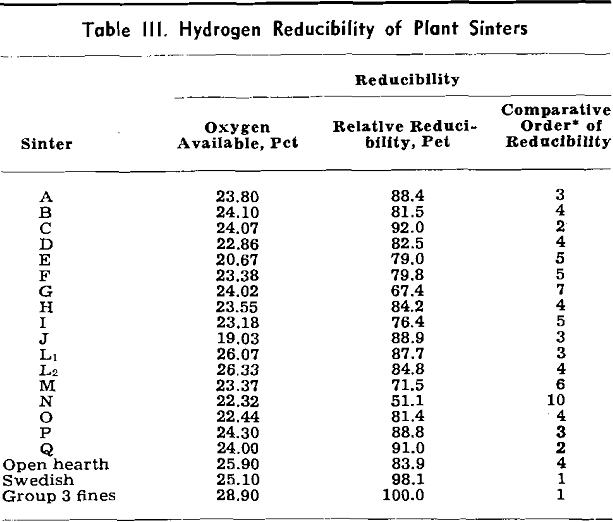This report to the American iron and steel industry marks the completion of a 1949 survey of blast-furnace sinter practice sponsored by the Sub-committee on Agglomeration of Fines of the American Iron & Steel Institute. The use of sinter in blast furnaces, sinter properties, raw materials, and sinter plant operation have been reported recently.
Each 400-lb grab sample of sinter was secured at a time when it was believed to represent normal production practice at each plant. It was not possible to use the same sampling procedures throughout the survey; consequently samples were taken from blast-furnace bins, cooling tables, and railroad cars. These were very useful for evaluation of test methods, since they were obtained from plants with widely divergent operations.
Chemical Analysis: Table I presents chemical analyses performed on the survey sinter samples. Included in this table are data obtained from determination of FeO and the slag relationships: CaO + MgO/SiO2 and total slag (CaO + MgO + SiO2 + Al2O3 + TiO2). The percentage of FeO was used as an indication of the percentage of magnetite in the sinter. It was believed that slag relationships could be correlated with sinter properties.
Strength Test by Impact: In evaluating sinter quality, one of the properties stressed most by blast-furnace operators is strength. This strength may be described as the resistance to breakage during handling of sinter between the sinter plant and the blast-furnace bins. It is also the strength necessary to withstand the burden in the blast-furnace. After

extensive experimentation with the tumbler test, static crush test, and impact test, the impact test (adapted from one originating with the Jones & Laughlin Ore Research Laboratory, was found to be more suitable in the laboratory with regard to simplicity of operation, time required, and ease of representing strength values.



Surface Area Measurements: In assessing the properties of blast-furnace sinters, mention is often made of surface area available for gaseous reduction. B.E.T. nitrogen adsorption measurements for determination of surface area have been conducted, on —0.093 + 0.065 in. sieve size fractions. Of special interest is the tremendous difference in surface areas between sinter and group 3 fines iron ore, the latter being 89,000 sq cm per g, while highest surface area for sinter was on sample
Porosity Test: An evaluation was made of the S.K. porosity test for determining porosity of sinter. Test equipment and procedures were adapted from those used by the Oliver Iron Mining Div. laboratories of

U. S. Steel Corp. This test was originally developed in South Kensington, England, at the Imperial College of Science and Technology.
Davis Tube Magnetic Test: It has been felt by many investigators that the degree of oxidation is an important factor in determining strength and reducibility of sinters. An evaluation was made of a

Davis tube magnetic tester which magnetically separates the magnetic particles in a —100 mesh sample.
X-ray Diffraction Analysis: X-ray diffraction analyses of all the plant survey sinters were made to determine relative amounts of magnetite and hematite in each sample. Table VI gives the results obtained by X-ray diffraction. Prior to obtaining these values, the X-ray crystallographers prepared a curve of percentages of hematite and magnetite vs relative line intensities using physical mixtures of cp-grade hematite and magnetite.

Slag Relationships in Sinters: the slag ratio CaO + MgO/SiO2 and total slag (CaO + MgO + SiO2 + Al2O3 + TiO2) of the plant sinter samples. Although FeO might have played an important role in affecting slag properties, its accurate determination in slag content of the sinters was an insurmountable problem at the time.
In a discussion of test results in plant survey sinters, the inadequacy of sampling based on a 400-lb grab sample of sinter at only one period must be taken into account. Furthermore, since there is no assurance that representative samples were secured, no comparisons can be made between the plant sinters. The important results of the experimentation were the development of test methods and the fact that a marked differentiation could be made between sinters of such varying compositions. It is hoped that some plants will be sufficiently interested in results of the tests reported to apply these methods in production trials on their sinters. Such trials, combined with blast-furnace production and operating data, would be of value in establishing requirements for good sinter in the blast-furnace.

